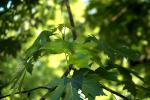COLUMBIA, Mo. – Anthracnose is a group of fungal diseases that cause dark, sunken lesions on leaves, stems, flowers and fruit of many deciduous trees.
“The fungi live in the trees,” said Hank Stelzer, forestry specialist for University of Missouri Extension. “In other words, it’s part of our natural world.”
Stelzer says anthracnose a perennial springtime problem in sycamores, but it can also show up in other hardwood trees such as maple.
It’s not limited to trees. Patricia Hosack, director of the MU Extension Plant Diagnostic Clinic, says she’s diagnosed it in Boston ivy and roses this year.
Even though anthracnose is always there, the weather needs to be just right for symptoms to flourish.
“It really likes a cool, wet spring when the leaves are emerging and their tissue is soft,” said Hosack.
The good news is that anthracnose typically doesn’t cause severe damage.
“It’s mostly a cosmetic disease,” Hosack said. “It makes the leaves look bad.” It’s usually found on the lower leaves in a trees’ canopy, where the humidity is higher. The tree will eventually drop the damaged leaves.
Even if it drops a large number of leaves, the tree can still recover if it is healthy.
“Trees have a secondary set of buds and they will re-leaf if it’s early enough in the season,” Stelzer said.
Once warmer, dryer weather arrives, the fungi will retreat, Hosack said.
The fungi can survive the winter in debris dropped from the tree. Stelzer says the best way to keep anthracnose at bay is good sanitation. Pick up fallen leaves and twigs from infected trees and destroy them, he said.
For more information about anthracnose on shade trees, go to http://soilplantlab.missouri.edu/plant/diseases/anthracnose.aspx.
Read more http://extension.missouri.edu/news/DisplayStory.aspx?N=2541





